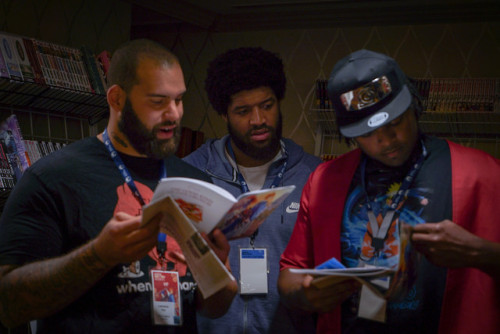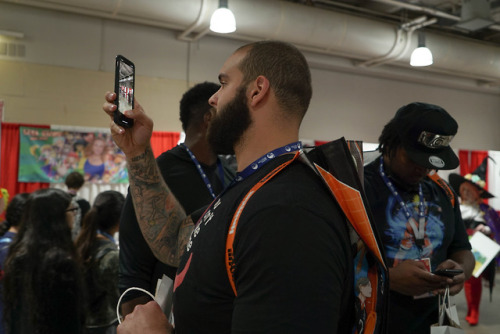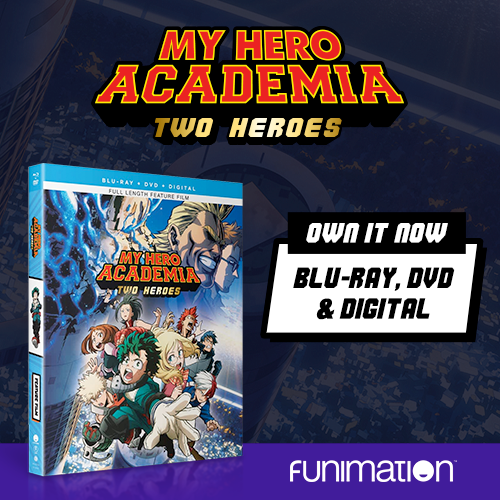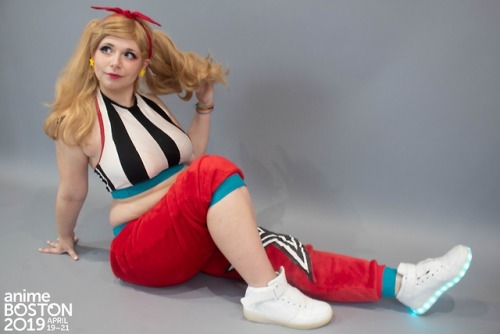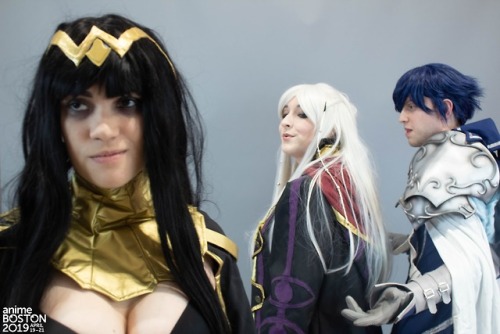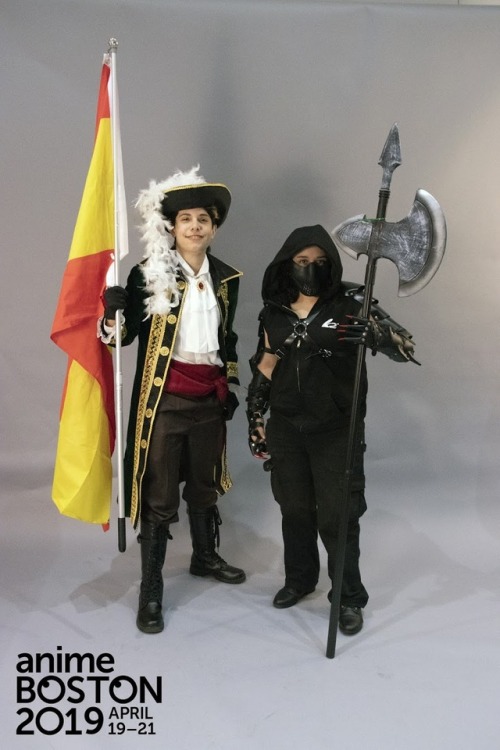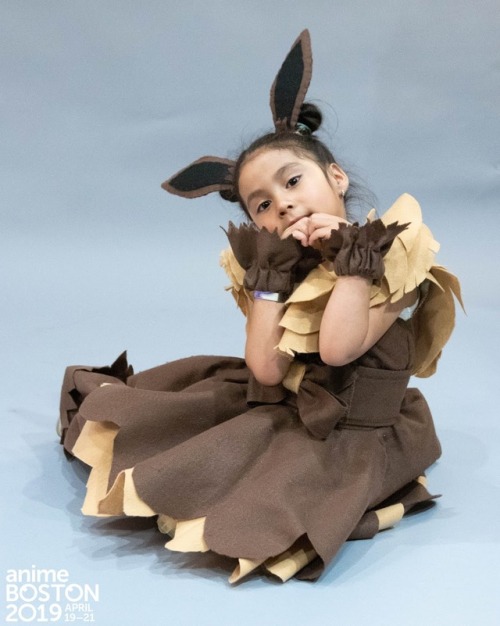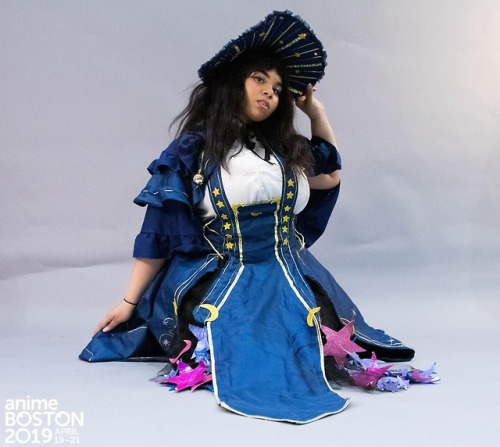You know about Gundam, but when it comes to the enormous offering of mecha anime out there, that title is just scratching the surface. In “All The Mecha You’ll Ever Need,” panelists recommended some of their favorites that may surprise even mecha fans.
Read on to learn about the panelists following five favs:

Space Runaway Ideon
Immediately following Mobile Suit Gundam, famed director Yoshiyuki Tomino moved on to a new show that plays with a lot of the same thematic issues. Space archaeologists, including one with a sweet afro, find a giant red robot on a distant planet. Director Hideaki Anno says this show is part of his inspiration for Evangelion.
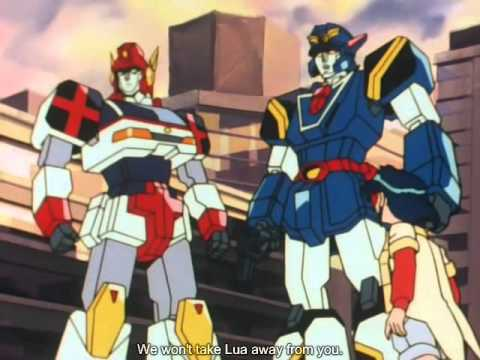
Brave Police J-Decker
In the line of Patlabor, this is a police sitcom with giant robots. This over-the-top anime features robots who have a lot of personality: including a giant robot who likes to lift weights. This show never forgets that it’s all in fun and embraces this attitude wholeheartedly.

Last Hope / Juushinki Pandora
After the apocalypse, the people of the Pandora unit have to protect the city. From rats with buzzsaw arms to crabs with missile launchers, all of the animals are evolving into biomechanical monster things. It’s a Japanese/Chinese co-production so it also contains a little bit of Chinese mysticism and quantum physics.
Last Hope is available on Netflix

Goshogun
At first glance this show seems serious: the main robot is piloted by a former gangster, and all the battles are set over classical music. But by the end, this show acknowledges its funnier moments with a little bit of a fourth wall break. There is a running joke in the show where the villains run side businesses, like a knock-off Disneyland and imitation KFC.
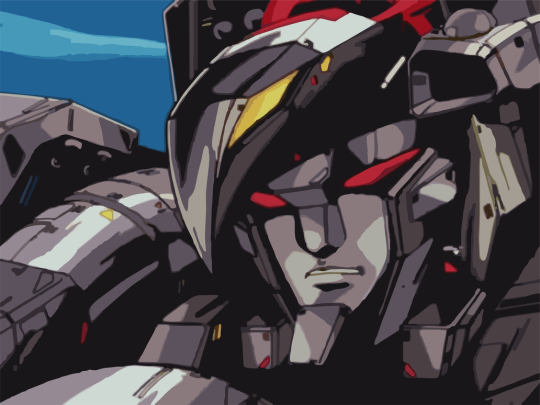
Dancouga
This is famous for being one of the first shows that Masami Obari worked on. It’s a bit surreal, like when the bad guys learn there is a flower that smells likes heartbreak, but only to women. So they modify the flower so that women who breathe it become homicidal maniacs. Because that’s logical. It takes a full 15 episodes for the robot to transform for the first time, and part of its combination sequence inexplicably includes a hat and shoes.
— John, AB Staff Blogger

Above: Sailor Moon, as portrayed by Taylor Hobbs and photographed by Kayhettin.
Cosplay is for everyone, but to cosplay as a minority means to deal with an unfair volume of microaggressions from onlookers, like the one in the title of this post. MoonlightBailey, a young woman of Haitian/Dominican Republican descent, said she’s dealt with plenty of them in the seven years since she began cosplaying.
In her panel Black Nerd Magic, she reminded cosplayers of color that they look fantastic. “Please don’t quit cosplay because of somebody’s dumb comment,” she said. As part of her advice, she offered some tips for dealing with common offensive comments:
Stay silent and keep walking
When somebody makes an ignorant cosplay about your cosplay or your skin color, sometimes the best option is to pretend you didn’t hear. “These people feed off of attention,” she said.
In some instances, correct and educate
If a commenter seems to be acting in good faith, gently let them know the error of their ways. “Somebody said to me, ‘You’re dressed like the black Harley Quinn!’ and I told them, ‘No, I’m dressed like Harley Quinn.’”
Brush it off with humor
MoonlightBailey asked the audience how they’d respond to a few jabs like, “Wow! I’ve never seen a black Wonder Woman before.” One audience member suggested a joke: “I would just say, ‘Wait, I’m black?’ and act like I’m having an existential crisis.”
Travel in a group
MoonlightBailey said that she is quick to stand up for herself, but it doesn’t come easily to everyone. If you’re nervous about clapping back to strangers, she suggested traveling in a group in order to significantly reduce confrontational interactions.
Be confident! You look great
Most of all, MoonlightBailey reminded her audience, a mixed group of diverse cosplayers, that they all look awesome. “Cosplay isn’t about skin tone, or gender, or age, or race,” she said. “It’s about loving a character and being a big nerd. Being comfortable in your cosplay is the key.”
— Lauren, AB Staff Blogger

Ten years ago, Code Geass season 2 ended with, in my opinion, a very satisfying ending to one of my favorite anime series. So when it was announced that, ten years later, a Code Geass sequel movie would be coming out, I had a fair amount of trepidation. Funimation decided to bring the new movie, Code Geass: Lelouch of the Re;surrection, to Anime Boston for its east coast premiere, so I leaped at the opportunity to see if it’s a worthy revival. Short version? Yes.

Before showing the film, Funimation had a panel with Johnny Yong Bosch, voice actor for Lelouch, and Yuri Lowenthal, voice actor for Suzaku. Turns out they shared my trepidation. When asked his thoughts about revisiting the franchise, Bosch said he was “a little divided,” expressing satisfaction with the previous conclusion, but he said that “Coming back is exciting.” They also didn’t know if the show would still matter, with Bosch commenting “Ten years later, maybe nobody cares anymore.” Well based on the packed auditorium the premiere drew, it’s clear that Code Geass still has a strong fanbase. As for what to expect from the movie, without any spoilers, Lowenthal said “There’s fan service in this movie.”
Boy is Lowenthal right. This movie is full of fan service, though I’m not using that term in the usual titilating way (though there is some of that). I’m talking fan service in terms of giving the fans what they expect from the characters. Lelouch is scheming and arrogant. Suzaku is courageous and gets into multiple Knightmare Frame battles. Basically, if a character survived the end of season 2, they showed up in Re;surrection.
But fan service doesn’t make a great movie. At the heart of Code Geass is a battle of wits between schemers played out on a grand scale. I wasn’t sure the movie would deliver that, as the first 60 minutes or so didn’t really have any of that. But then the twist dropped, and the movie became incredibly compelling. There are still some parts that don’t really make sense, but it’s not enough to detract from an otherwise compelling battle of wits.
If you’re completely satisfied with the ending of season 2, I can’t say that this is necessary viewing. But if you enjoyed Code Geass and want some more, this movie should satisfy you. And more Code Geass is what you can expect, since Funimation rep Tara McKinney said that the producers of the movie have a ten year plan to continue the Code Geass franchise. If this is where it starts, I’m curious to see where things go next.
If you’re interested Also, Funimation is donating a movie poster which has been signed by Bosch and Lowenthal for the Anime Boston charity auction. If you’re interested, stop by Panel A tomorrow at 10:00 AM and you may take it home with you.
- Andrew, AB Staff Blogger
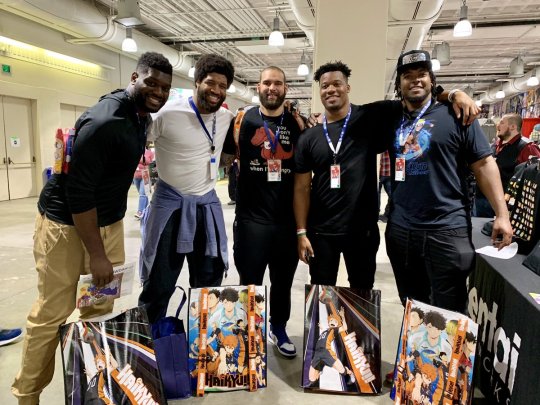
Above: Photo via Sentai Filmworks on Twitter
Saturday is by far the busiest day of Anime Boston, welcoming people of all stripes to the convention floor. Among those visitors were some members of the 2019 Super Bowl champions, the New England Patriots. Five athletes and anime enthusiasts—Lawrence Guy, Adam Butler, Deatrich Wise Jr. Keionta Davis, and Ufomba Kamalu—came to see the sights, get guest autographs, and generally geek out.
Anime Boston first became aware of the New England Patriots’ soft spot for anime in an article about Lawrence Guy’s locker room anime club. Anime Boston’s public relations team reached out to the Patriots to offer a visit, and the team enthusiastically accepted.
“None of the players had been to an anime convention before and they didn’t know what to expect,” said Chris O’Connell, director of Public Relations for Anime Boston.
At the convention, the Patriots’ first stop was the green room, where Anime Boston’s special guests spend time between appearances at the con.
“The athletes were thrilled to meet the guests, especially the English dub voice actors, and the guests were likewise excited to meet Super Bowl champs,” O’Connell told the blog team. “Everyone was signing each others’ stuff in the green room, and it was hard to tell who the fans were and who the celebrities were.”
The Patriots visited the Anime Boston dealer’s room, took a photo with their new swag from Sentai Filmworks, and dropped by the video game room.
“When they got there, Billy Kametz [the English voice of Josuke in JoJo’s Bizarre Adventure] was playing Super Smash Brothers, and Adam Butler asked him for a game,” O’Connell said.
Anime Boston has something for everyone, whether you’re young or old, new to anime or experienced, and from all walks of life from student to Super Bowl champion. Thanks for stopping by, New England Patriots, and we hope to see you again next year!
— Lauren, AB Staff Blogger
Believe it or not, Japan’s beloved Godzilla turns 65 this year! Panelist Off-Kilter celebrated this anniversary–and his own personal love of Godzilla–in his Saturday morning panel Go Go Godzilla!: A 65th Anniversary Retrospective. A packed crowd turned out for the panel, with the age range naturally including older fans who got to personally witness the monster’s debut in the mid-1950s.
The iconic monster burst onto the silver screen for the first time on October 27, 1954. In addition to capitalizing on the science fiction/horror/monster flicks that were popular during this time period, the film was also a statement against the effects of war and nuclear weapons. Two years later, U.S. audiences were introduced to the monster in Godzilla: King of the Monsters, which was basically footage of the original Godzilla with scenes featuring Raymond Burr as a reporter describing the horrors he is causing.
While no doubt the definition of “awesome” to generations of people, Godzilla was not without his embarrassments–and Off-Kilter was more than happy to share some of these moments with his very appreciative audience. Here are some of the ways Godzilla has embarrassed himself over the past 65 years.
Yes, even more so than he did in the 1998 U.S. Godzilla movie.
Godzilla can fly!
Godzilla has the best, albeit gravity-defying, drop-kick of all time!
Godzilla is an adorable, clumsy Hanna-Barbera character!
Godzilla played basketball with Charles Barkley!
And yes, Godzilla has a victory dance!
Let’s face it: Mario is just as synonymous with video games as Pikachu, Sonic, or ridiculously priced downloadable content. In his panel Plumber’s Log: Through the Years with Mario, Shadow Wolf Z took video game fans on a tour of the life of everyone’s favorite turtle-stomping plumber.
Here are some highlights–and low-lights–of Mario’s history that were covered in the panel.
- The character debuted in 1981 as the protagonist in Donkey Kong. Back then, he wasn’t even Mario; he was just known as “Jumpman” (a name that would be more fitting for Luigi). It wasn’t until the original Mario Bros. game a few years later that he would be named…and given a brother.
- So, where did “Mario” come from? Video game creators definitely didn’t need to look far for their inspiration: he was named after Mario Segale, who was the landlord–not a plumber, but the landlord–renting the Nintendo company a warehouse outside of Seattle in the early 1980s.

- Super Mario Bros. 3, one of the most beloved games in the entire series, also had the absolute best commercial to promote it (despite it showing absolutely nothing about the game).
- Mario makes cameo appearances in other Nintendo games, perhaps the most well-known being his role as the boxing ring ref in Punch-Out!!! He has also popped up in NES sports games Golf and Pinball and, if you angle it correctly, in a painting in the Legend of Zelda: Ocarina of Time.


- If you were a child of the 80s, you no doubt remember the cringe-worthy Super Mario Bros. Super Show, which combined cartoons based off of Super Mario Bros. and (the North American version of) Super Mario Bros. 2 with low-budget, live-action segments starring wrestling star Captain Lou Albano as Mario and Canadian actor Danny Wells as Luigi.
This show was Oscar material compared to its replacement series: Club Mario. The (thankfully) short-lived series kept the cartoons intact, but replaced live-action Mario and Luigi with “Tommy Treehugger” and “Co M.C.,” two hip-as-far-as-out-of-touch-TV-executives-are-concerned Mario fanatics who spent their days on a rooftop in some random city.
Mario had countless video games. He had several TV series. He even had a movie (which we will never talk about in public). But did you know that he even had his own line of products? At the peak of his popularity in the late 1980s and early 1990s, Nintendo licensed their mascot for everything, from a breakfast cereal to mac and cheese to even shampoo.


–Mike Fenn, AB staff blogger

Forty years ago, in April 1979, Mobile Suti Gundam first aired on TV. That means that April 2019 is the Gundam franchise’s 40th anniversary!
To commemorate the occasion, there’s no time like the present to get started building Gunpla, the plastic models you can build into accurate miniature replicas of Gundam mobile suits. In “Let’s Build A Gundam!” panelist Colin Becker shared a few tips to get you started:
Know the difference between grade and scale
Gunpla kits are labeled by grade and scale. The grade indicates the complexity and usually appears like two letters. HG, for example, means “high grade” and indicates a generally simple level of complexity. More advanced builders may pursue MG, AKA Master Grade, or others.
On the other hand, scale simply refers to the size of the finished model kit in comparison to its “real life” size. If a Gunpla says it is a 1/144 scale, that means it is 144th the size that the actual Gundam mobile suit would be if it existed in real life.
Pick a Gunpla that fits your level of experience
You’ll have the most fun if you use the grade and scale guidelines to choose a model kit according to your skill level and interest. Don’t pick an extremely complex Master Grade for your first kit—it’ll take forever and be frustratingly difficult. Instead, you might want to select a small simple SD (Super Deformed) Gunpla that takes just 30 minutes to build.
You don’t need a lot of tools
No toolkit? No problem. All you really need is a pair of nippers. They don’t need to be official Bandai nippers or even hobby nippers, but can be miniature wire cutters from a hardware store or jewelry nippers from a craft store. Use the nippers to snip the Gunpla pieces out of the sprue they come out of the box in, and use your hands to snap the pieces together from there.
Advanced techniques can elevate your Gunpla
When it comes to Gunpla building, the sky’s the limit! You can repaint every part of a Gunpla with spraypaint or even an airbrush to create a custom color scheme. You can even mix and match parts from two suits of the same grade to make a unique hybrid suit. Some modelers even create elaborate diorama settings in which to pose their finished Gunpla.
But remember, there’s no wrong way to build a Gunpla!
Even though the Gunpla Builders World Cup shows a lot of creative ways to build kits, you don’t have to do anything elaborate if you don’t want to. You can just build Gunpla out of the box with no additional tweaks, pose them and enjoy. Gunpla is for everyone and you don’t need to have a minimum level of skill or experience in order to enjoy the hobby.
This weekend, why not pick up a Gunpla kit in the dealer’s room?
— John, AB Staff Blogger
From our sponsors @funimation:
Own the SMASH-hit anime movie!
Get it here: https://funi.to/MHA2heroes
#myheroacademia @myheroacademia
Post link

When most people hear the title JoJo’s Bizarre Adventure, they think of something like the image above: muscular, manly men doing masculine, testosterone-soaked things. There is a fair amount of that, but that’s not what JoJo really is. For all of its obvious masculinity, JoJo is also a show that runs deep with femininity, and it’s fascinating how those two aspects balance each other. That’s the thesis of the panel “Lipstick and Superpowers: The Femininity of Jojo’s Bizarre Adventure” presented by Shinyzack, IdolRinny, and Craig.
To start, they define femininity in this context as “beauty, intellect, and emotional availability”. Femininity does not mean weakness. Strength can go hand in hand with beauty and emotional availability. Just look at how beautiful Giorno is:

One hallmark of JoJo is characters solving problems using intellect. Multiple examples of this occur in Stardust Crusaders, where the enemies aren’t as strong as the protagonists, but they use intellect to negate that strength, forcing the protagonists to use their own intellect to solve the problem, rather than just being stronger or tougher than the enemy.

There’s also emotional availability. The characters are tough, but they’re also generally in touch with their emotions and able to express them to others. There are many examples of manly men shedding manly tears in JoJo.

Another example of this femininity is the motivations of the main characters. Many shonen protagonists want to gain something for themselves. Naruto wants to become the next Hokage, Luffy wants to become King of Pirates, and so on. The JoJos all have selfless motivations. Jonathan wants to protect his family and supernatural entity from destroying the world. Same with Joseph. Jotaro wants to save his mother’s life. These are people trying to protect the weaker people around them, not trying to gain for themselves.
But this isn’t to say that JoJo is a feminine show. No, their thesis is that JoJois a show about balancing masculinity and femininity, and how doing so makes the characters more well rounded and compelling. And it’s that willingness to incorporate elements from both sides of the traditional gender binary that gives what’s otherwise a silly show about superpowers and poses the depth that many shows lack.
Also, seriously, JoJo’s Bizarre Adventure is awesome.
- Andrew, AB Staff Blogger
In Fall 2016, queer figure skating anime Yuri!!! on Ice made history. But long before this anime became a global hit, series director Sayo Yamamoto was shaking up the anime industry.
Since her directorial debut at 25, Yamamoto has been bringing her unique style to anime series you might not even know she was responsible for directing. Panelists (and prolific Yuri!!! On Ice fanfiction authors) Songbird SaraandMagrathea shared some of the highlights of her career:

Samurai Champloo
One of Yamamoto’s earliest gigs was working as a storyboard artist beneath Cowboy Bebop director Shinichiro Watanabe. She once said that in her early career, working on Samurai Champloo was the first project where she felt she was first able to truly express herself.
Samurai Champloo is available on Hulu.
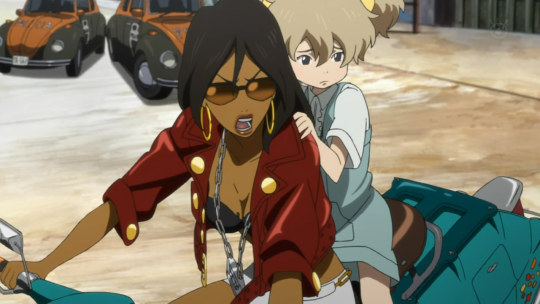
Michiko & Hatchin
A love letter to South America, this anime is Yamamoto’s main directorial debut. Its commitment to an accurate portrayal of Brazilian culture is indicative to what she would become known for: her dedication to heavily researching the stories she tells through anime.
Michiko & Hatchin is available on Funimation.

Lupin the III: The Woman Called Fujiko Mine
Yamamoto had full creative control over this 2012 iteration of Monkey Punch’s iconic Lupin III story. She prioritized animating Fujiko’s body the way a real woman’s body would move. Unfortunately, this show is not currently streaming anywhere (but available on DVD).
Persona 5 opening movie animation
Yamamoto directed the opening sequence for this Atlus title available on PlayStation 4. Yamamoto interest in figure skating is overtly reflected in this animation, where Joker and his crew spin and glide.
Endless Night
This five-minute short is a direct predecessor to Yuri!!! On Ice. In 2015, Yamamoto produced this music video with choreography by figure skating choreographer Kenji Miyamoto. It follows the story of a young boy dreaming of becoming a professional figure skater, and even includes a pair skating sequence evocative of Yuri!!! On Ice episode 12.
What is your favorite Sayo Yamamoto title?
— Lauren, AB Staff Blogger

On Friday night, MIYAVI rocked the crowd at Anime Boston. The “samurai guitarist” played his greatest hits to a packed ballroom of enthusiastic fans.
If you’d like to listen to his tunes at home, we’ve helpfully recorded his full setlist:
- Words Collide
- Flashback
- In Crowd
- Dim It
- No Sleep Til Tokyo
- Tears on Fire
- Can’t Stop It
- Otherside
- Long Nights
- Fire Bird
- Raise Me Up
- Day 1
- Dancing With My Fingers
- Fragile
- Wonderful World
- What’s My Name

MIYAVI, who was born Takamasa Ishihara, is 37. A musician, actor, and philanthropist, he has been performing since 1999 in the visual kei, glam rock, and j-rock music genres.
Read more about MIYAVI on his Anime Boston guest page.
Photos by Vu Tran.
— John, AB Staff Blogger
Selections from the Anime Boston Friday Photo Suite. Get your photo taken in cosplay for free in Hynes 102!
Post link
Presenter Jerry Crowley gave his debut Anime Boston panel on Friday evening entitled Pilgrimage to the Holy Land: Anime Tourism. He explained that, once the space-age and science fiction era of 1970s and 1980s anime cooled off, the medium moved into “slice-of-life” offerings in the 1990s and beyond. Settings were moved from distant fictional planets to actual locations throughout Japan.
In the mid-2000s, the Japanese government took notice of this and encouraged local governments around the country to capitalize on their small claims to fame. Unlike in the U.S., where local residents tend to grow irritated at the increased tourism movie and TV show notoriety provides (just ask any given person trying to enter the Philadelphia Museum of Art as dozens of “Rocky” fanatics race up the steps alongside them, to varying degrees of completion), things are thankfully different in Japan. Local areas embrace the anime that put them on the map in many ways, leaving tourists and locals alike happy at the end of the day.
If you are heading to Japan anytime soon, check out some of these locations for yourself!
Sailor Moon - Kimi-Chan statue
Azabu-juban, Minato Ward, Tokyo
Fans of Sailor Mercury in particular will appreciate seeing this statue.

Yuri!! On Ice - Karatsu Castle
Karatsu, Saga Prefecture
Cleverly, it became “Haratsu Castle” for the anime.

Zombie Land Saga - Yakitori restaurant
Imari, Saga Prefecture
Fun fact: the owner of the restaurant voiced himself in the episode!

K-On - Toyosato High School
Toyosato, Shiga Prefecture
You can actually go in and tour the school, seeing just how detailed the K-On animators were able to get with the interior scenes.

–Mike Fenn, AB staff blogger

The University of New Hampshire Anime Club is a fairly successful club. However, their tongue-in-cheek panel offered some reverse-psychology advice about how not to run an anime club. Here’s some advice you shouldn’t follow so your anime club runs smoothly:
Don’t pick a good club advisor
Having a club advisor who isn’t interested in anime is a great way to make sure your middle school, high school, or college anime club fails. Instead, the panelists suggested finding a teacher who is interested in anime themselves, and ask the school librarian first.
Make every con meeting an out-of-control party
Don’t act like a leader, just be everyone’s friend and let people do whatever they want… if you want the club to be an irresponsible mess, that is. Instead, you as the anime club organizer will need to take a leadership role, and sometimes that means having to step in and tell people things they don’t necessarily want to hear, like that it’s time to quiet down.
Pick all the anime yourself
Only you know which anime is good and bad, so definitely don’t let the members vote on selections for the club to watch. Sike. Instead, let people bring legal, licensed anime picks for the club on at a preview night. You might find something you didn’t know you would like!
Ignore any social problems
If somebody in the club is being bullied or having a bad time, just ignore it. You don’t want to make it awkward! Kidding of course. Being a leader means knowing when you can’t solve problems on your own. Know when to get a teacher involved.
Blame everything on yourself
Problems with club paperwork? Somebody didn’t like the club and left? It’s all 100% your fault. No, please don’t do this to yourself. Being a leader means owning your own actions and their consequences, but you can’t be responsible for things outside of your control. And don’t be afraid to talk to your fellow officers or your club advisor if you need help.
— John, AB Staff Blogger (And Former College Anime Club President)
One in four adults in the United States has a disability, but the representation of disability in media is few and far between. But it’s still there! Partners for Youth with Disabilities, the group that gave the Autism in Anime panel at Anime Boston 2018, highlighted some of the best anime and manga that include disability as a theme.

REAL
This manga from Takehiko Inoue, the creator of Slam Dunk, tells a story about wheelchair basketball players. This story, which has been ongoing in Shonen Jump since 1999, focuses on a teen who becomes a paraplegic after an accident, but still continues to pursue basketball.
REAL is available in English on Amazon.

Perfect World
This ongoing manga by Rie Aruga is published by Kodansha. It tells the story of 20-something Sugumi, who reunites with her first crush from high school, Itsuki. He works on helping disabled people find accessible housing, and the story doesn’t sugarcoat the struggles of his daily life.
You can read Perfect WorldonKodansha.

Megalo Box
While the main character, Joe, is not disabled, this anime takes place in a world where characters are surgically modified with metal frames that make their attacks more lethal. When removed, they cause permanent damage. The show explores themes of PTSD in veterans, acquired disability, and the intersection of trauma and disability.
Megalo Boxisstreaming on Crunchyroll.

Jojo’s Bizarre Adventure - Part 7 - Steel Ball Run
Johnny Jostar, the protagonist of this section of the story is a paraplegic athlete. However, he is never defined by his disability. Living in the magical world of the story, Johnny balances fantasy adventures with depictions of his daily life as a disabled athlete.

A Silent Voice
Written by Yoshitoki Oima, this manga turned movie tells the story of Shoya, a boy who bullies his deaf classmate, Shoko. Later, while trying to make amends for his earlier mistakes, Shoya learns JSL and finds a re-connection with Shoko. This movie is a particularly good representation of deaf culture since Shoko is voiced by a deaf actress.
You can read A Silent VoiceonKodansha.

GANGSTA
Written by Kohske, this monthly comic turned anime has been running in the @Bunch magazine since 2011. It tells the story of Nicholas, a deaf assassin who uses lip movements and vibrations to process sound. It shows how living with this disability affects his unusual life and career.
GANGSTAisstreaming on Hulu.
— Lauren, AB Staff Blogger

Keeping up with all the anime that comes out is impossible. In Spring 2019, there are 33 full length anime series airing, plus 13 short series. In this endless cavalcade of new anime, it’s easy for a high quality show to fall through the cracks. That’s why The Toddfather has revised his longrunning panel “Anime You Might Have Missed” to include anime from the last few years which fell through the cracks. While you may have heard of or seen these series, they’re shows that didn’t get the recognition they deserve. Shows like:

Blood Blockade Battlefront - Imagine if New York City and a supernatural New York City from another dimension got fused together, leaving NYC as a bizarre gateway between our world and another. This show follows the adventures of a group of people from both worlds who aim to preserve peace in the city. Based on a manga by Yasuhiro Nightow, who also created Trigun and Gungrave. Streaming on FunimationandCrackle.

Land of the Lustrous - LotL focuses on a group of gem people, known as the Lustrous, who have to defend themselves from invaders from another world, but it focuses on the youngest Lustrous who is unable to fight. It’s also the rare CGI anime series that actually looks good. Unfortunately, it was released on Amazon’s short lived Anime Strike service and was ignored. Now it’s just streaming on basic Amazon Prime.

Run With The Wind - A group of college students get roped by one of their friends into becoming a running team and aiming to run the most physically challenging team marathon in Japan, the Hakone Ekiden. It’s a sports anime, but it’s not hot blooded youths yelling and getting pumped up. Instead its intelligent, mature adults working to find motivation and improve. Streaming on Crunchyroll.

Skull-face Book Seller Honda-san - This is a short series about a skull faced worker in a book store. It’s a joke a minute commentary on low wage retail work and Japanese pop culture, complete with the bashful main character having to help a foreigner find a particular kind of yaoi. Streaming on Crunchyroll.

SSSS.Gridman - Think Ultraman with over-the-top action, but with a twist: whoever gets killed by attacking kaiju is forgotten by everyone except for the main character. This show is proof that, even after Darling in the FranXX, Studio Trigger can still make quality anime. Streaming on CrunchyrollandFunimation.

Wotakoi: Love is Hard for Otaku - Wotakoi is the story of a boy who reunites with his childhood friend and they start dating, except instead of high schoolers, they’re adults who work together. Also, they’re both massive otakus, which complicates things. This is a show that finds comedy in adult otaku conversations, like whether it’s okay for someone to “ship” her boyfriend with her friend’s boyfriend. Another victim of Anime Strike, this is now streaming on basic Amazon Prime.
- Andrew, AB Staff Blogger

What if I told you anime’s fierce female fighters had their inspiration in real life history? It’s not only the Strike Witches, but real ladies from the past, who have fought for Japan.
Military historian and Anime Boston convention panelist Haru Menna regaled his audience with tales of onna-bugeisha, female martial artists, from Japanese history. Here are five of the most famous, and the shocking exploits we still remember them for today.

Tomoe Gozen
Dubbed Japan’s “Beautiful Samurai,” Tomoe was born in 1184. The Heike Monogatari accounts her exploits, including the final battle she was ever involved with, in which she was the only survivor. Legend has it the only man she couldn’t kill, she married instead. In modern times, she is depicted yearly in the Jidai Matsuri parade in Kyoto.

Tsuruhime of Omishima
Born in 1526, Tsuruhime became the chief priest of the local shrine at age 16 after her father, the previous head priest, died. As a Shinto priest, she was the living embodiment of their local god. As a god, it was easy for her to become the local military leader as well, and she led the armed resistance against pirates trying to take over her hometown.

Miyagino and Shinobu
The woman warriors come as a pair! After a drunk samurai on the run, drunk, killed their father, a farmer, the younger sister (Shinobu) brought a word of the murder to her big sister Miyagino, working as a courtesan in Edo. For seven years they searched for the murderer and trained in hand-to-hand combat. After they found him, their local lord approved their request for a legal duel to the death, two on one. It is said that the murderer died… swiftly.

Nakano Takeko
In 1868, the imperial army put Nakano’s hometown, the city of Aizu, under siege. She formed a unit of about 30 teenage girls, known as the Joshigun, to defend the city. They faced off against 100 imperial soldiers with American Spencer rifles, armed only with naginata. When the imperial army saw their opponents were girls, they asked them to come forward so they could be taken prisoner… That’s when the dismembering began. Nakano sliced through six soldiers in a matter of minutes, and took seven bullets before she went down.
— Lauren, AB Staff Blogger



